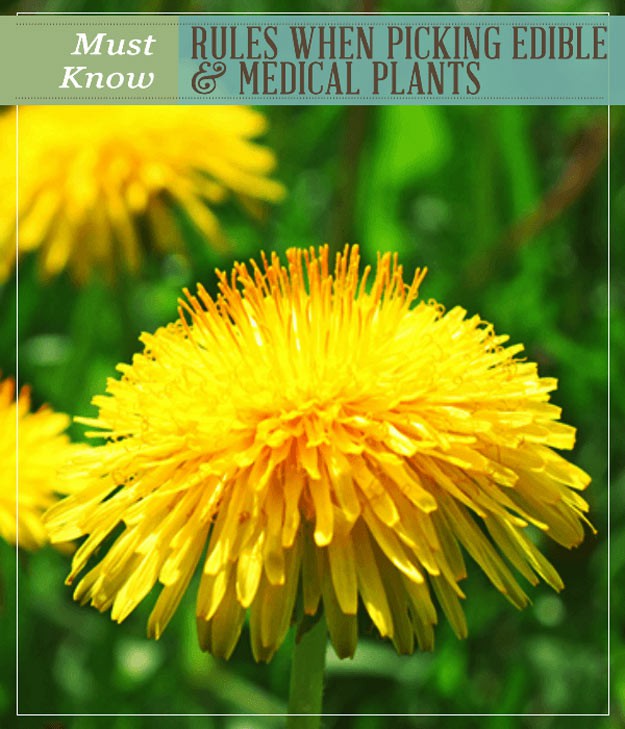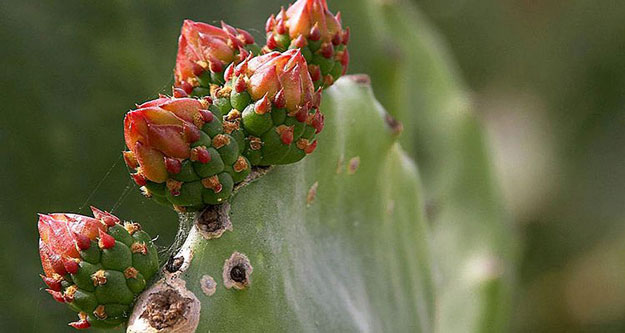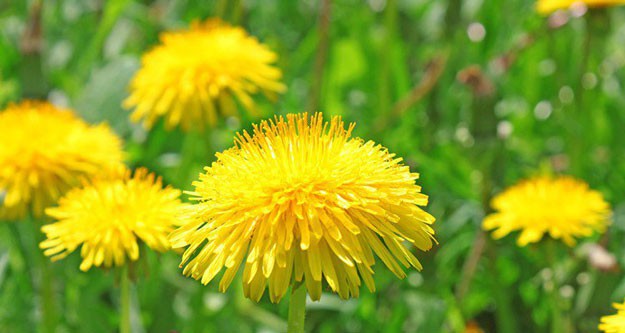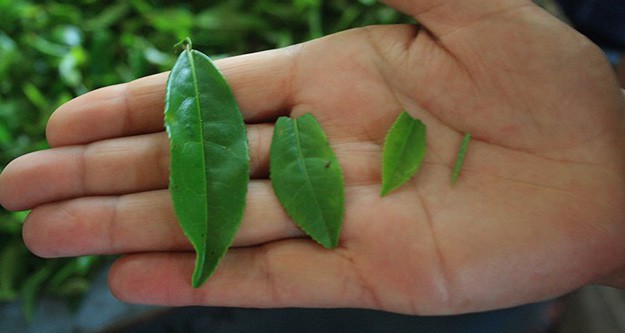Knowing edible & medicinal plants is important in self-sufficiency and if you plan to live off the grid. There are must know rules in picking them and I'm going to show you what they are. You don't have to guess what plant is edible or medicinal, you just have to follow a couple of rules and get familiar with them. As with every homesteading skill, you have to learn it to know it!

Picking Edible & Medicinal Plants – Must Know Rules
Next to mastering fire, a knowledge of picking edible & medicinal plants is considered one of the most difficult, complex and one of the truer signs of being a genuine expert in homesteading. There are other skills like hunting, fishing and trapping that are good marks of a woodsman and skills like navigation, orienteering and terrain association that are standard fair for an outdoor adventurer.
But mankind has always had an interest in the plant world as even now, we are constantly learning about seemingly miraculous properties of plants through science that still feel like some sort of magic to most. And indeed, plants can be magical, but they can also be deadly.
Perhaps that is why so many people have a fear of them. We see plants all around us, every day, but most of us do not know what most of them are. We may know a few from our personal experience but most people could not name 100 different plants that surround them daily and they have grown up with all their lives. It makes sense as there are literally millions of plants, it becomes a daunting task to learn them all.
Picking Edible & Medicinal Plants

But like anything in life, we have to break it down into small steps we can handle and before long, we’ll have it mastered and have the confidence that comes with skills acquired through training and familiarization. I try to teach everything in the simplest terms I can as that helps me to remember not only what to teach when in a dynamic scenario, but it also helps me personally to remember when in a stressful situation.
The main thing you have to start out with is setting realistic goals and expectations. There is no way you can learn all the plants in the world. That’s a good start. The next thing is to realize that you don’t need to know them all. I use some simple figures to put it into perspective. These are not scientifically proven, yet, as I don’t think anyone has ever had need to do this type of study, but here are my guidelines for plant edibility versus animal edibility.
90% of all animals are edible for humans.
Only 10% of all plants are edible for humans.
Again, I know these are not the finite facts, but think about it, in the absence of a report on the global edibility of everything, does this not resonate? Anyone with common sense and a bit of world knowledge can come to the same deduction, I can eat almost every type of animal and even insect, bird or fish, or reptile with few exceptions. BUT, I know most plants I can not eat, such as trees or bushes, vines or roots, all for one reason or another, maybe too fibrous and hard, or too noxious or toxic. That is why the few plants we can consume as humans, are so highly cultivated, farmed and used by man kind. Here's what you have to know about edible & medicinal plants.
Pretty AND edible. Check out this list of flowers you can eat! https://t.co/CLDcDxYQ6W pic.twitter.com/F7b0U3Nxmu
— Homesteading (@HomesteadingUSA) July 1, 2016
Edible Plants
I say all that to say this, you simply don’t need to master all the world’s plants, you only need master a few. Here are some guidelines I help use to help myself determine which plants to dedicate some time to learning, and even mastering.
1) Make sure any plant you decide to learn and master is IDENTIFIABLE. I always look to see if there are any poisonous plants that look like a potential plant I want to learn. For example, cow parsley has a poisonous look-alike called poison parsley that requires a refined eye to differentiate. It’s simple enough if you study but a mistake can be disastrous. I tend to steer away from any plants that have poisonous look-a-likes, unless they simply are so abundantly around me, I could not logically forego mastering the identification of them.
2) That is the next determining factor before I decide to dedicate time to studying a plant as potential for an emergency or survival food source- abundance. Is the plant PLENTIFUL? Meaning, are there lots of it about? It does little good to know the identity and edibility of some plant if it is so rare, you are likely never to encounter it, especially when needed most in desperate times. So make sure there are lots and lots of it about.
3) The other key to helping narrow down your choices of plants to master is DISPERSION. If the plant is only found in one region, or on one mountain or valley, chances are you won’t be in a hurt box in that specific location. And if you were, likely those plants would indicate where you are and you could then find your way out! The key here is how widely distributed are the plants? Are they found all over the world? Are they growing everywhere? These are crucial to the survivor as you want to make sure you have mastered a few plants and that the mastery will pay off in that when you need, you will find, because they are indeed, all over the place.
So Remember: D.I.P. (Distribution, ID, Plentiful)
Now that we have QUALIFIED the screening criteria let us take a D.I.P. into the world of QUANTIFYING our survival plant mastery stratagem. I like simple numbers, so I use 12 here for plants. My recommendation for how many to learn is this:
MASTER 6 to 10 EDIBLE plants based on the criteria above and 2-6 MEDICINAL. Choose these from which ever environment is most important and likely to you for need- Home region, Work place, Travel Areas or anywhere you think you might need this knowledge. Most folks live and work in the same region but some people travel to remote areas for work and need that knowledge in case of emergencies while there.
Some great plants to learn come in many variations, sometimes in over a hundred different forms, but they all basically are from the same family, look alike enough to be easily and readily identified and eaten almost year round in some form or another.

A few common, edible plants:
- Dandelion
- Cat Tail
- Acacia
- Cactus
- Roses
- Acorns (Oak trees)
- Pine needles (Pine trees)
- Arrow root
- Bamboo/Reed/Cane
- Seaweed
These are just some examples of plants that are found all over the world, in many varieties with almost no toxic similarities that are DISPERSED, IDENTIFIABLE & PLENTIFUL.
BUT NOTE: Another significant factor often overlooked by most books and experts is one so simple but so important the lack of discussing and addressing can often lead to uncertainty and lost opportunity to thrive. The season!
Everyone knows there are 4 seasons and that means a lot in the life cycle of plants. It is easy to identify a plant in its full glory of blooming fruit and flower, but what about in the spring, when only a bud, or in the fall, when key leaves may have fallen off, but some nut is perhaps ripe for eating or in the dead of winter when all above ground looks dead to the world above, but below the surface lies a great tuberous root waiting for the forager who knows how to identify the stem when all other signs have long gone.
Medicinal Plants
Next, I recommend learning at least 2-3 MEDICINAL PLANTS but balance your mental garden of 12 plants total, that you master for your start point.
Ideally, these can also be in the EDIBLE category, too, but simply prepared differently or using different parts like roots and leaves versus fruits or nuts from the same plant.

One of my biggest guidelines for learning medicinal plants is to study the PREPARATION that is needed to render them as a medicine. Anything that requires boiling means a fire and a pot and water, often not available to a survivor. So, I recommend things you can chew or crush and apply as a “chew poultice” or direct dressing.
The most common issues people have are fever, aches and pains. Anything like aspirin will help and it is the acetylsalicylic acid that makes aspirin work and similar properties like salicin can be found in many plants around you like willow and even oak tree barks.
Another major issue is tummy upset and diarrhea. There are many plants that can helps sooth and stop these such as dandelion and cat tails. Notice, these are also from the suggested food list so that you can now master 12 food plants and some double as your medicine plants.
The real trick to mastering plants is to simply narrow your focus to a dozen you can handle, then really learn them- all seasons, all parts, all ways to prepare and all uses.
The secret to vanquishing fear in survival is by reducing the stress of ignorance by knowing a dozen plants in your environment that you can eat and use for medicine. In this way, you are well prepared and you can spend the rest of your life building on and expanding this knowledge, but you can learn these plants in a day, master them in a weekend. If you practice with those plants around you before you need them, it will ensure your skill sets and assure you the confidence in your abilities to choose wisely under duress, reducing stress, vanquishing fear and living to see another day and return to your loved ones.
So, study your chosen plants from the perspective of all four seasons to enhance and ensure your ability to not only survive, but thrive. Pick 12, give it a day, own it and go hot!
Need more tips? Get more here from Ultimate Survival Tips:
Does this guide make you feel more confident picking out edible & medicinal plants? Let me know what you think below in the comments!
Follow us on instagram, twitter, pinterest, and facebook!
LIKE this? I'm sure you'll LOVE:
The Top 5 Ultimate Medicinal Herbs For Your Bug Out Bag
32 Edible Flowers | The Complete List Of Flowers You Can Eat!

Wow, such simple ideas that make sense. I’ve wanted to learn more edible plants and also medicinal, for emergency situations, but was so overwhelmed by how many plants there are, that in many years, I still have never even read one book on it.
Simpifying it down to learningl just a few and know them well from all seasons, etc makes this task seem more doable.
Thank you. I will break this down to a manageable size as you have suggested. Do you have a suggestion on listing the 12 most important?